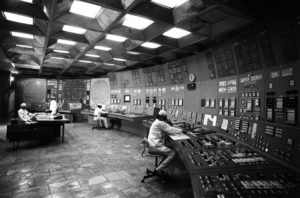
In the Russian language, there is a massive literature in mainstream publications pointing out the inconsistencies and absurdities of the official Soviet and western line on the event. Recently, Nikolai Kravchuk, formerly of the National Academy of Sciences Institute for Theoretical Physics and a graduate of Moscow State University.
Kravchuk states that the malfunctioning reactor, reactor #4 of the RBMK-1000 class, had been tampered with for some time before April 29, the Jewish Passover for that year. He writes: “From 1 to 23 April 1986, the state of the reactor core changed significantly. This was not accidental, but the result of well-planned and deliberate policy.” He argues that the reactor was adulterated with Plutonium-239, making the reactor unstable. There is no explanation as to why a highly enriched fuel was pumped into this reactor. It would serve no purpose except for its destruction.
The official version of events in the former USSR (written by NA Steinberg) states that “human error” was the culprit. Staff “cutting corners” and not following daily protocol ultimately led to the disaster. At one point shortly after the news hit the stands, Gorbachev said a “hydrogen explosion” caused the rupture, but soon changed that to a “chemical explosion.” The IAEA states that human error, plus several design flaws in the reactor led to disaster. The Soviet and IAEA Commissions ultimately combine poor workmanship, poor staff morale, poor training and a general culture of laxity led to high pressure warnings not being noticed and routine maintenance not being done.
The claim was made that the plant worked poorly at low power levels, and that the graphite control rods were shorter than they needed to be. The problem with the “design flaw” arguments is that the RBMK-1000 is considered one of the most reliable reactor types in the world and is used throughout the globe. This model of reactor has been in use for decades with no problems.
In 1989, a reactor in Petersburg, also RBMK-1000, , imitated the identified conditions that allegedly led to the Chernobyl disaster. While no nuclear fuel was involved, the Petersburg unit meticulously re-created the same high pressure situation theta allegedly led to the 1986 debacle. No explosion or anything close to it occurred. In fact, researchers were shocked that even far worse conditions did not lead to any explosion or leakage. The reactor showed tremendous strength even when deliberately pushed to the limit. They proved the official version false.
Kravchuk notes in his book, “Mystery of the Chernobyl Disaster” (AIRO-XXI, 2011) that qualified staff were asked to not show for work on the day of the explosion. Anatoly Dyatlov was chief engineer of the plant, and claimed before he was sent to prison that he “was acting from orders from above.” These orders were never ascertained (Kravchuk, 73-80).
Contrary to popular belief, the Chernobyl nuclear power plant was built not to meet the growing needs of urban Kiev, but to supply a unique military base “Chernobyl-2.” This complex of giant transmitting and receiving radio stations was nearby. The radar was its main asset, called the “Duga 1” and was designed for the early detection of long range missiles. It was a legitimate military target of the US.
It turns out that just 25 seconds before the explosion of the fourth reactor, many seismic stations scattered across the globe recorded a strange high-frequency seismic wave. The frequency of an earthquake is much lower than what was recorded. The source of this high-frequency wave was directly under this reactor and the explosion occurred once the wave made the integrity of the reactor unstable.
All the normal failsafe protocols were not used and all safety mechanisms had been disabled. In Kravchuk’s book, he asks the question “Why the reactor was not plugged immediately after they cut off the steam from the TG-8, as regulations demand, especially in a time of instability? Really — did none of the staff understand the danger of these circumstances, including the head of the testing crew Dyatlov?”
While many of the facts to this day have yet to be fully gathered (since much was destroyed in the waning days of the USSR), some of these issues will not be known for certain. However, it is quite probably that the Chernobyl disaster was not an accident, but an attack on Russia.
(Translations by Matthew Raphael Johnson)